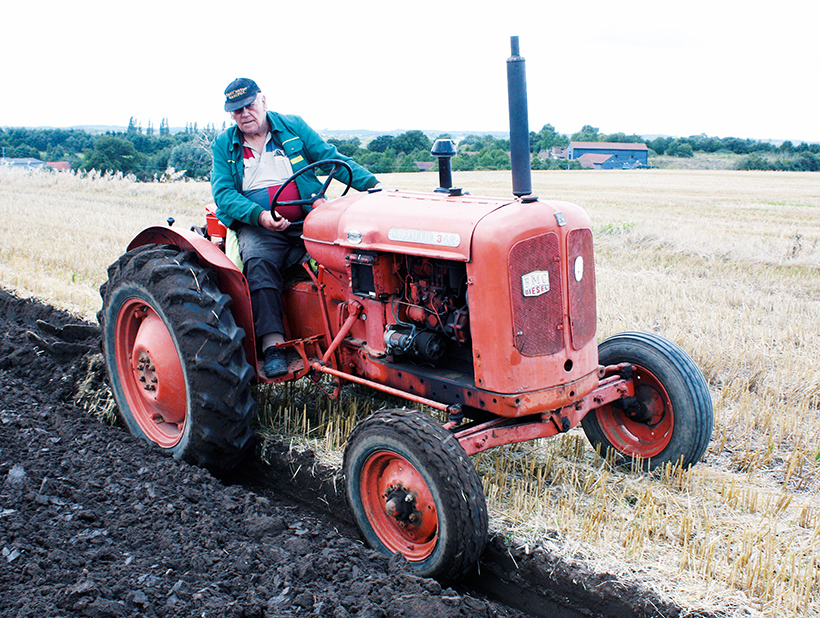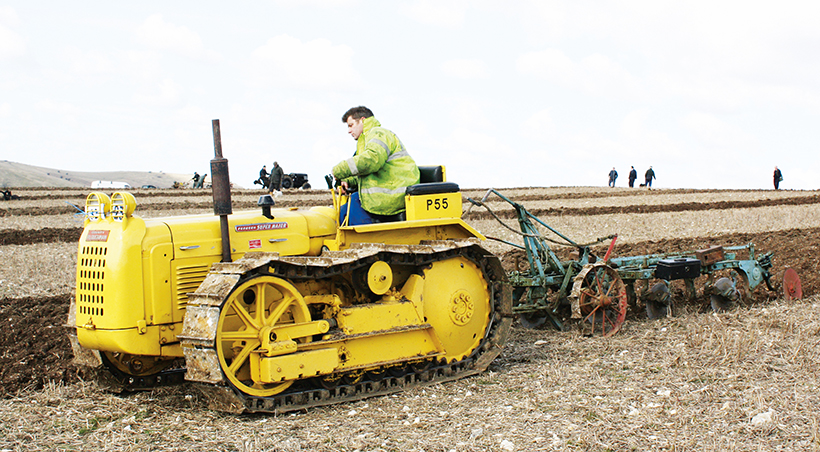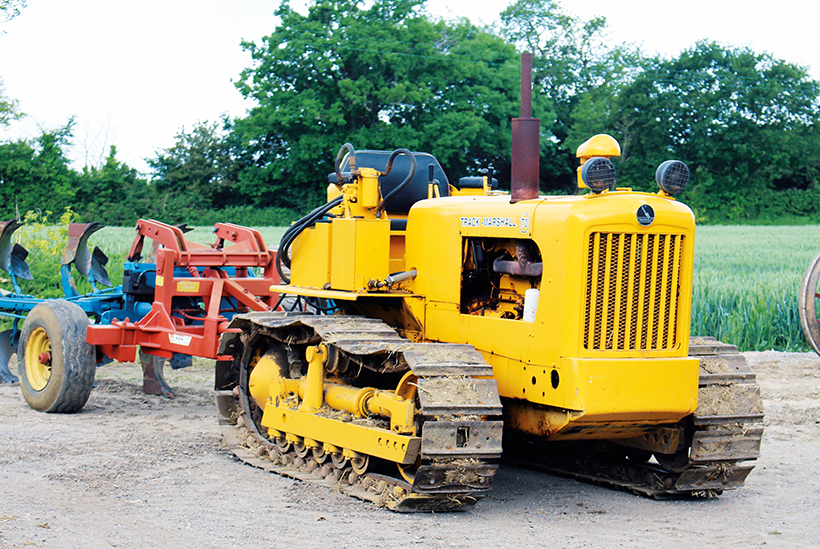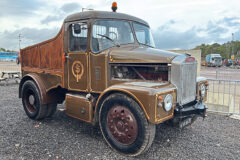The fascinating development of the humble farm tractor in the 1960s
Posted by Chris Graham on 15th January 2024
Jonathan Whitlam looks back at the 1960s, that was a decade that saw a quantum leap in the development of the humble farm tractor.

Humble farm tractor: The Ford Motor Company began the 1960s with its latest evolution of the E1A Major tractor, a hugely popular machine produced at Dagenham, in Essex. This latest incarnation was called the Super Major – an apt title, as it had many new features over the earlier versions, including the Qualitrol draft control system and disc brakes.
The history of farm tractors is one of constant development and innovation that, at times, seems to take a leap forward rather than a gradual evolution. One of those occasions is the 1960s, a decade when tractors changed their character forever!
It began with models carried over from the 1950s that were built for certain markets around the world, but by the middle of the decade the emphasis was firmly on brand-new ranges that were designed to be sold worldwide.
The 1960s ended with the design of safety cabs to be fitted during 1970, and thus, the 1960s saw perhaps the most change of any decade in the 20th century when it came to the agricultural tractor, particularly in Britain.
In this series of articles, we shall look at how that came about, with an emphasis on the British market.
Blue and red
The 1950s had seen many changes, as new designs of tractor came on stream following the end of WW2 and the gradual easing of the shortages of materials afterwards.

The Fordson Super Dexta arrived in 1962 and was a more powerful version of the original Dexta. It saw the traditional styling tweaked slightly to showcase its greater power output. The inclusion of the Super Dexta gave Ford a three-model range of tractors for the UK.
Of all the various tractor manufacturers, some of which were new, the two that sold the most were Ford and Massey Ferguson.
The Ford Motor Company had taken a dual approach to tractor manufacture globally, with the North American market being supplied with home-produced, Ford-badged machines that were based on the Ford 9N with Ferguson System that first appeared in 1939. This would be the basis for American Ford tractors right up to the middle of the 1960s.
In contrast, in Britain the Fordson name was still used for the Ford tractors built at the large factory in Dagenham, Essex. After a major upgrade at the end of 1951, the Fordson E1A Major had been produced right through the rest of the 1950s, evolving into the Power Major in 1958, but essentially staying much the same.
Ford also had the Dexta from 1957, a tractor to fill the smaller, lightweight tractor market. As 1960 came around, the Power Major and the Dexta still complemented each other until the Super Major replaced the former during the year.

Massey Ferguson launched the 65 in the UK at the end of 1957, as a rival to the Fordson E1A Major variants, and a big brother to the 35. It was based on a North American design and even kept the styling it first wore as the Massey-Harris 50 and Ferguson 40. It gave MF a strong, two-model line-up in the UK by the time 1960 came around.
This was quite a big upgrade of the E1A design, but was still very much an evolution of the previous model, a practise that as we shall see was very common during the early years of the 1960s.
A third tractor arrived from Ford in 1962 with the introduction of the Super Dexta; a more powerful version of the little Dexta, giving Ford a larger range of models than ever before in Great Britain and starting the trend towards a series of models, rather than just one larger one and a smaller one, as had been the norm since 1957.
When it came to Ford’s main rival, Massey Ferguson, despite the merger of Massey-Harris and Ferguson taking place in 1953, a truly amalgamated new tractor range did not arrive until the end of 1957, with the 35 and 65 proving popular in the UK right into the 1960s.
The 35 was by far the best-selling of the two and had its origins in the Ferguson 35 of 1956, that itself was based on the American developments of the TE-20.

The ultimate version of the Massey Ferguson 35 arrived in 1962, in the shape of the 35X.
By 1959 the 35 had been updated with a Perkins three-cylinder diesel engine and in 1962 also gained the Multi-Power transmission that gave more ratios thanks to a gear ‘splitter’.
The 65 was a larger, more powerful, four-cylinder tractor that was largely based on North American designs, but featured a Perkins diesel engine, and was built to take on the likes of the Power Major, and then the Super Major.
It made a gallant attempt but was not quite as successful as the blue machines, despite the introduction of a MkII version with a better engine. The 65 might not have been quite as popular as the Major, but Massey Ferguson had a very strong presence in the tractor market in Britain in the first half of the 1960s – the 35 being the best-selling small tractor on the market by a long margin, despite the growing competition.
The red International Harvester tractors had been built in Yorkshire since the 1940s. The little B-250 and B-275 had been the company’s opening into the lightweight tractor segment and the former was built from 1956 until 1961, while the B-275 was introduced in 1958 and remained in production right up until 1968, such was its popularity.

International Harvester had enjoyed much success in Britain with the larger Farmall-based tractors, but it was not strong in the small, lightweight sector of the tractor market, hence the introduction of the B-250 in the middle part of the 1950s and then the B-275 at the end of the decade. The latter was a machine that remained popular throughout the 1960s.
In fact, IH tractors of the 1960s did not change that much, especially in comparison with the other manufacturers. For example, the B-450, introduced in 1958, was built right through to 1970.
The first ‘new’ British IH tractor of the 1960s was the B-414 that first appeared in 1961, although that had much in common with the B-275, while the larger B-614 followed in 1963.
The company had also enjoyed much success with crawler tractors during the 1950s, both for agricultural and industrial use, and these continued unchanged during the early 1960s.
The IH format at this time really seemed to be a very slow evolution of its tractor models, and of all the large manufacturers it was IH that seemed to stick with tried-and-tested designs for the longest.

International Harvester crawlers were very successful in Britain during the 1950s, although crawler popularity would dwindle during the 1960s, when machines such as the BTD-6 were still being produced.
Orange and pink
Allis-Chalmers was very much an American company, but it did have quite a large presence in Britain when, in 1947, the famous Model B was prepared for the British market using tractors imported from across the Atlantic.
From 1950, a factory in Essendine, Rutland, was acquired by Allis-Chalmers and production of tractors moved there, the Model B being replaced by the D-270 in 1955 and joined by the D-272 in 1957.
Both models were based heavily on the row-crop design of the old Model B, and it took until 1960 before the company launched the ED-40 tractor – a larger machine, although one still heavily row-crop based and therefore something of an anachronism.

Allis-Chalmers produced the ED-40 tractor to be a rival to the mainstream tractor models sold in Britain, but by keeping with the firm’s traditional row-crop design, and by choosing to use the four-cylinder Standard Motor Company diesel engine that had already received a bad reputation for starting in cold weather when used in the MF 35, Allis-Chalmers ended up producing a tractor that had limited appeal and was in many ways rather outdated when introduced in 1960.
It also used the Standard Motor Company’s four-cylinder diesel used previously in the FE 35 and early red and grey MF 35 tractors. The ‘English Diesel 40hp’ was not a success, even though it continued to be built throughout the ’60s.
Allis-Chalmers HD crawlers were also sold in the UK and were reasonably successful, with the machines of the ’60s largely based on earlier versions and including some very large machines aimed more at the industrial sector.
The 1960s was the swan song for A-C in the UK however, certainly when it came to wheeled tractors, and the firm would not develop anything more after the ED-40, even though it remained strong in its native North America.
David Brown had been established as a tractor builder from 1939, based near Huddersfield in Yorkshire, and had enjoyed much success with its ‘Hunting Pink’ (red) machines, both at home and abroad.
By the end of the 1950s, the new Implematic era, beginning in 1958 with the launch of the new 950 model, had succeeded in getting the company’s reputation back on track after a rather disastrous first attempt at a new model with the unreliable 900.
Building on the success of the 950, David Brown launched the smaller 850 in 1960, followed by the 880 and 990 Implematic in 1961, producing a range of tractors of very similar design all incorporating the firm’s advanced hydraulic control features.
The 880 and 990 soon became successful models for the company and there was even the option of an automatic transmission for a short time, although it did not sell very well as it was too far ahead of its time and, of course, cost extra.
The Nuffield brand was started in ’48 by Morris Motors and soon garnered a reputation for quality tractors.

The David Brown 990 Implematic proved to be a very popular model for the Yorkshire-based company.
The orange machines had evolved slowly from the original version into the Universal Three and Universal Four during 1954 and these two models, reflecting three- and four-cylinder engines, continued into the new decade before being replaced by the very similar looking 3/42 and 4/60 – the new model designations reflecting the engine’s cylinders and horsepower rating.
The new models’ introduction in 1961 coincided with a move from the original production site of Birmingham to a new factory at Bathgate, Scotland, the following year. This was a politically derived move, as the government wanted to offer jobs to those that had lost work due to the closure of coal mines in the area.
The tractor range would remain very similar looking throughout the 1950s and most of the 1960s, reflecting a gradual evolution of the Nuffield product.

The Nuffield 3/42 was introduced in 1961 and produced at Bathgate, Scotland, from the following year. As a three-cylinder model it replaced the earlier, very similar, Universal Three.
Bright yellow
Caterpillar crawler tractors were a well-known import from the USA and the D Series was the most successful of all, the range begin launched during the 1930s and then evolving over time.

As the 1960s arrived, crawler tractors were still enjoying a high level of popularity, although this would change markedly as the decade progressed. County had been making crawler conversions of Ford tractors since 1948, and the Ploughman P55 arrived at the beginning of the 1960s – based on the Fordson Super Major skid unit.
Originally imported from Illinois, many Caterpillar machines were also built in Glasgow from 1958 and during the early 1960s the D4C was seen as the ideal crawler for agricultural use, but was only one of a range being offered.
The 1960s though, saw the beginning of a slow downturn in sales of crawlers for use in agriculture, as the rise of the four-wheel drive tractors gradually began to phase them out in all but the heaviest of soil conditions.
Marshall, based in Gainsborough in Lincolnshire, had not produced a wheeled tractor since the MP6 of 1956, the last of which was built in 1960, but the crawler side of the business was flourishing under the Track Marshall name, based on products that were originally built by Fowler of Leeds under the Challenger name.
When it came to Gainsborough crawlers, the Track Marshall 50 was hugely successful after its launch in 1956 and was joined by the 55 in 1959, and then the Track Marshall 70 in 1961, setting up the company as a leader of British-built crawler tractors during the early 1960s and one that continued to manage to grow its market share slightly, despite the beginning of the end for crawler tractors in the UK.

Track Marshall had an interesting history that included both the Marshall and Fowler companies. Built at Gainsborough in Lincolnshire, the 70 built on the earlier success of the Track Marshall 50 and these crawlers soon became the favourites of many heavy land farmers in the UK.
Purposeful conversions
Ever since the early days of the Fordson tractor there had been many companies converting the machine into varying types of specialist equipment.
County Commercial Cars, based in Hampshire, was quite late to the table, considering its fame today, and did not produce a conversion of the Fordson tractor until 1948, the machine being a crawler version of the E27N Major.
In the 1950s County produced many crawler conversions and a four-wheel drive machine called the Four-Drive, which used track-like steering with levers instead of a steering wheel.
Crawlers were still being introduced as the 1960s came along, with the Ploughman 55 based on the Fordson Super Major arriving in 1961 and the Clydesdale crawler in the same year, although these would be the last as crawlers were discontinued by the middle of the decade, the company now concentrating on four-wheel drive conversions.
The County Super-4 arrived in 1961, based on the Super Major, but with equal size wheels and a twin-prop shaft drive. It was a system that would form the basis for County four-wheel drive tractors for the next two decades. A more powerful six-cylinder version, the Super-6, arrived in 1962, using a Ford industrial engine.
Ernest Doe of Essex was an agricultural machinery dealer but branched out into tractor manufacture when it put a local farmer’s tandem tractor invention into production. The Doe Dual Drive concept was introduced in 1958 using two Power Major tractors joined together by a pivoting turntable and controlled by the driver on the rear tractor.

The most intriguing conversion produced using the Super Major skid unit had to be the Doe Dual Drive. This four-wheel drive machine used two skid units to produce a four-wheel drive tractor with pivot steering and an output of more than 100hp, making it one of the most powerful tractors available in the early 1960s.
In 1960 the tractor was produced using two Super Major tractors equalling 104hp. This powerful tractor was quite popular and was also exported to several countries.
The Matbro Mastiff 6/100MT was also an articulated tractor, but this time based on a single Fordson Super Major with a six-cylinder engine fitted. Launched in 1962, this four-wheel drive machine was only built in limited numbers.
Roadless Traction of Hounslow is probably one of the oldest converters of Ford tractors, producing tracked conversions as early as 1922. Crawler and half-track conversions were the norm until the firm began producing a four-wheel drive conversion of the E1A Major in 1956, under license from the Italian firm Selene.
The conversion, which used smaller front wheels to give a better turning circle, was fitted to the Super Major from 1960 and a smaller conversion to suit the Fordson Dexta was also produced. At the other end of the power scale, the Ploughmaster 6/4 was a four-wheel drive conversion of the Super Major, but also used a Ford industrial six-cylinder engine.
Action abroad
When it came to foreign tractors imported from either the USA or Europe, the 1950s and early 1960s did not see a big take-up of different makes by British farmers. American-built John Deere tractors had been sold by various businesses in the UK until they disappeared from the marketplace after 1951.
Things began to change in the early 1960s with a proper franchise arrangement by the Kent-based Lundell company seeing a few of the new American multi-cylinder tractors arrive in the UK – particularly the 4010 and 5010 models, which were large tractors and were not a type otherwise widely available in Britain. It would take until later in the decade before the green and yellow tractors really began to make their presence felt.

Another articulated four-wheel drive version of the Super Major was the Matbro Mastiff 6/100MT.
German Deutz tractors became available in the UK from 1961, with the air-cooled D-30 model being something very new to British farmers in its dark green paint scheme with red wheel centres. Air-cooled diesel engines were a common feature in Europe but had not made any impact in the UK at this time.
From 1959, German Porsche tractors were also available in the UK. These stylish little tractors were also powered by air-cooled diesel engines, and despite a history of tractor building going back to the 1940s, production ceased in 1964 – so not many were ever sold in the UK.
There were plenty of other tractor manufacturers in Europe, but it would be later in the decade before their products would become available in the UK, and slowly begin to rival the domestic companies. It was this fact that would also help change the British tractor market so dramatically by the end of the 1960s.
The early ’60s
The early 1960s was a time when British-built tractors dominated the UK market. Most of them were designs that had their origins firmly in the previous decade, and although ‘new’ models were introduced, most, if not all of them, were very much a continuation of what had gone before.

Roadless also recognised the need for more power and soon used a six-cylinder Ford industrial engine in its four-wheel drive Super Major conversion to produce the Ploughmaster 6/4 – the first in a long line of Ploughmaster-badged machines.
We have only just touched on the mainstream models, but there were also many manufacturers producing smaller machines that were more suitable for market gardening. Sadly, they fall beyond the scope of this article.
As we reach the middle of the decade, however, it soon becomes apparent that change was in the air, with the established players significantly altering their product range and newcomers beginning to make their mark.
In part two we will look at the huge upheavals that the middle years of the 1960s brought to the farm tractor – changes that would leave a lasting impression on farming, forever.
This feature comes from the latest issue of Tractor & Machinery, and you can get a money-saving subscription to this magazine simply by clicking HERE





